 VI
BIRD CAGE ACTION VI
BIRD CAGE ACTION
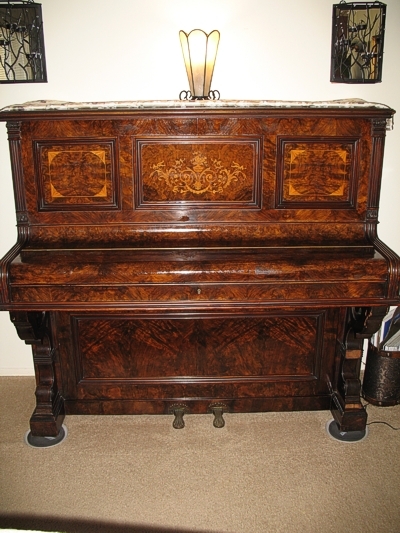
ACTION
BELOW: This is the strange action found in a number
of very old pianos from England, and a few from Germany. It
was a clever idea which never caught on. Typical of British engineering,
this action goes away around the barn to accomplish the obvious. Many parts
for this variety of action are not available anywhere. I have had to walk
away from about 15 of them. I have successfully tuned two I think. The tuning
pins on these pianos are almost always loose and beyond help. The sad thing
is that the cabinet is almost always in exceptional condition with inlay pictures
on the desk and varnish which does not darken with age. The makers of these pianos
used poor quality wood for the pin block and the structural wood of the frame.
This makes it almost impossible to restore them. Please
note the damper wire in front of the action. This is the source of the name"bird
cage" action. Also, can you figure out the action of the jack/sticker device.
This is a very strange way to make things work, but it did work. Joe Garrett
tells me that he restores a good number of these, and the thing I never realized
was that the ringing on caused by these dampers was what the makers wanted. They
wanted just a touch of ringing on for people who like the old sound or grandma's
piano. So, if the pins hold, and the thing plays, and it rings on a bit, have
it tuned. You may get a few more years out of the piano. Joe
Garrett restores square grands and bird cages as a specialty in Oregon. Call:
(503) 357-4713 Thanks to John at: john.jacob@bently.com
He did the exceptional job of the graphic. |
The
Bird Cage piano above shows the amazing cabinet work
done on these pianos.
This finish is about 130 years old, and
it has never been refinished. These
people had the secret to
keep the varnish from darkening. The sad part is,
they did
not work hard enough on the action and inside of the
instrument.
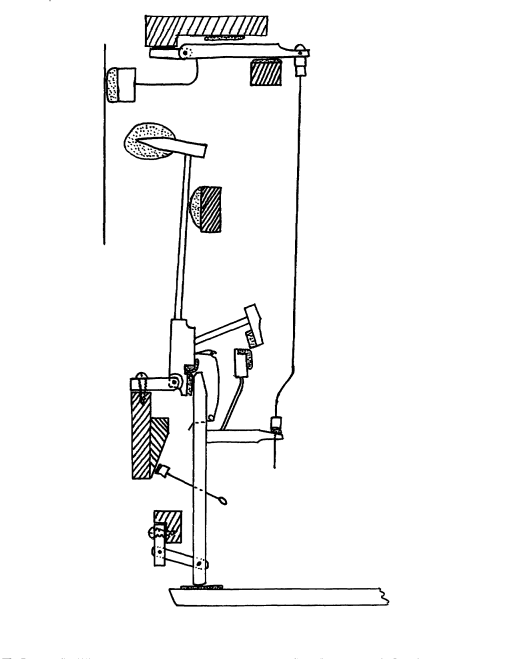
SOMEWHAT
MORE MODERN BIRDCAGE ACTION: Art
work by Mr. David J Gladman of Australia
The piano is a Steiner, date unknown,
probably from the UK Thanks to David
for doing very good work on this graphic. 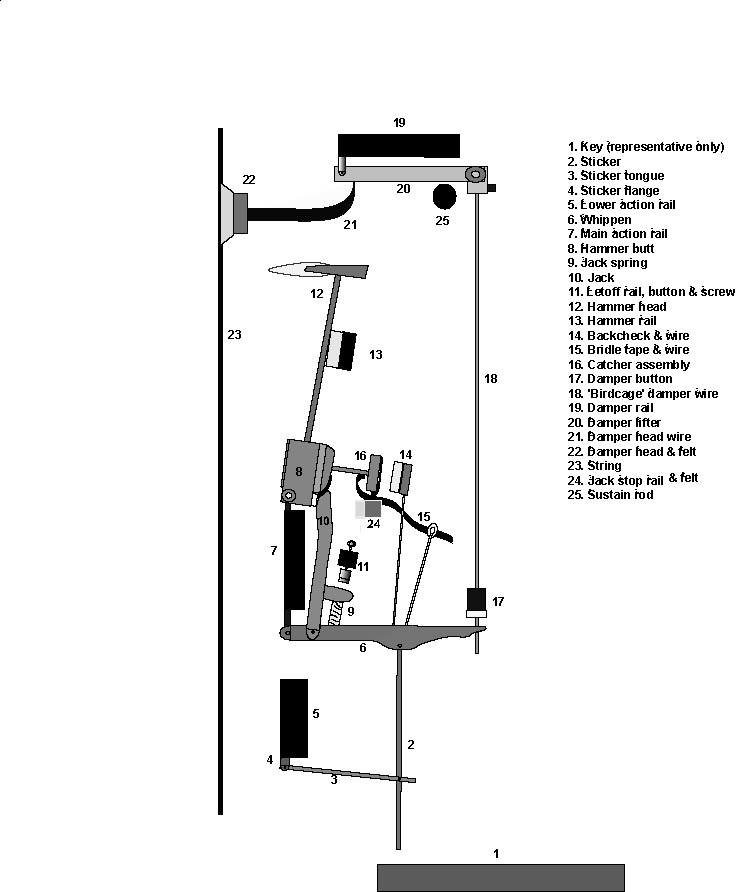
This action has the advantage of better repetition due to the
better back check and bridle strap arrangement.
The big problem with the birdcage
is that it seldom offers a way to take up on the damper as it wears at the top.
Also, the damper placement is not ideal in terms of damping nearer the middle
of the string as modern pianos do. The key lever work for
the above action also has the lever arrangement for the capstan as follows:
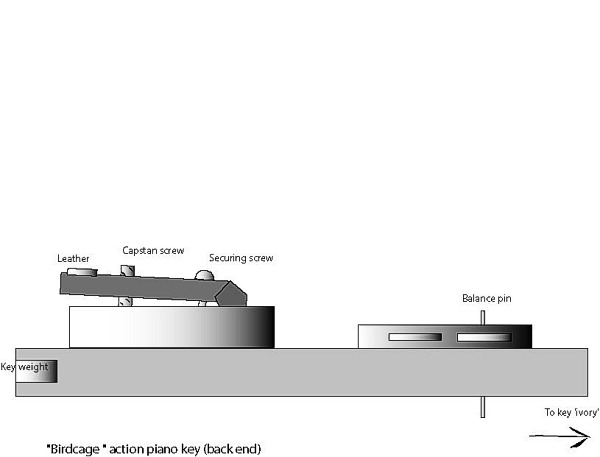
A BIRDCAGE
ACTION WITH MODERN WIPPEN
The damper is above instead
of below. This makes it even harder to mute I would think.
It has some conventional
parts though, and the damper felt would be easier to duplicate
from modern
suppliers. 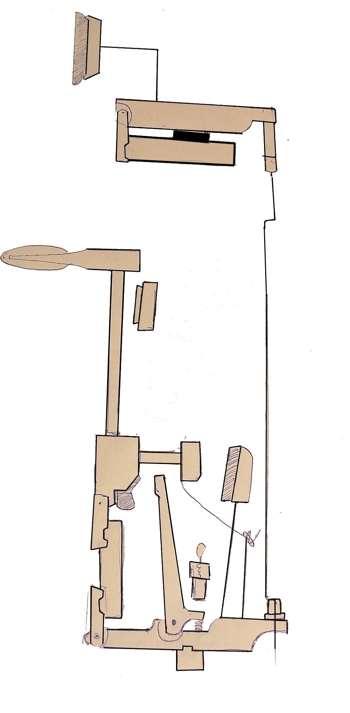
LETTER
FROM A CUSTOMER: This friend restored the action
of a birdcage piano from the UK, and I thought I would let you read his story:
Steve, I first contacted you about a year
and a half ago about the sanity of trying to bring an old Albert Price English
birdcage upright back from the dead. With a lot of hard work, good advice and
spare parts from you, a lack of common sense for knowing when to quit, and a good
deal of Divine intervention, I finally did it. I was pleasantly surprised
to discover that this instrument has an ABSOLUTELY GORGEOUS tone - not glassy,
not muffled, but bold & well defined. The soundboard is enormous - taking up the
entire 5-foot tall case. The cast steel harp is equally impressive, and all the
strings run up & down in parallel - no crossing over. Only very slight voicing
was needed (I used recordings of the Horowitz piano as a guide for what a real
piano should sound like.) The all-wood birdcage action (remember I
drew the diagram?), when finally regulated properly, sounds at the lightest touch
and repeats faithfully. This piano has a superb dynamic range from soft to loud.
I can only wonder at the fact that if I were "smart" enough not to
have started this project, and had known about the stuck keys, ruptured bridge,
bent shanks, loose pins, etc. etc. ahead of time, I would never have been rewarded
so richly. By the way, some friends have a Kohler & Campbell console,
and frankly I've heard Fisher-Price toys that sound better than that thing. So,
I guess the moral of this story is that a no-name box of piano junk might be a
jewel in hiding, while the beautiful one with status & honor might be worthless
as an instrument. There might be a lesson in Life in there somewhere,
too. Peace. John Jacob John did
the diagram above for me. 
 

Also, notice that the bird cage pianos are often so old that
they are not
over strung. This means the strings are not as long, and the
sound
is limited in volume. Note that the sound board also does not fill
the whole of the cabinet area available. The action does not have
any metal
braces. This makes for a lot of wobble in old age,
and the whole action needs
tightening because of this.
SEARCH
THE WHOLE SITE



BACK
TO PIANO TITLE PAGE BACK
TO THE CATALOG 
| 
